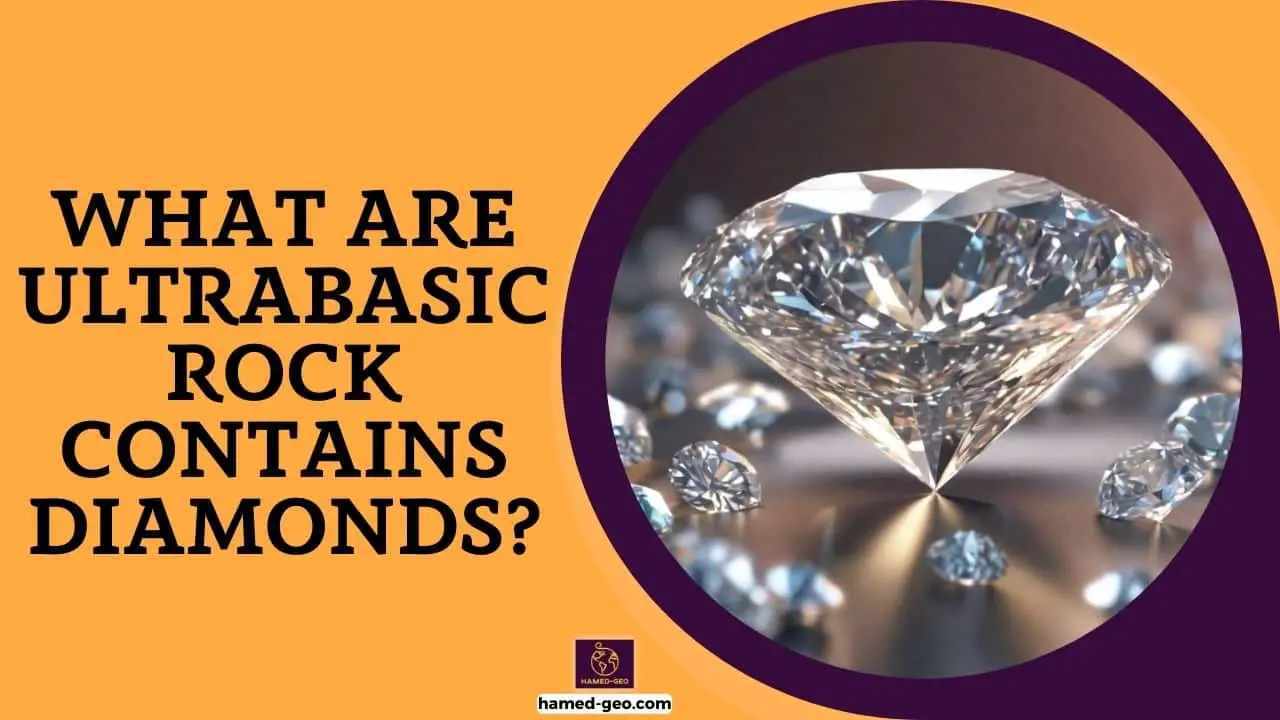Ultrabasic rocks are a distinctive type of igneous rocks that have a low silica content and high amounts of iron and magnesium. The bulk of the chemical composition of these rocks comprises less than 45% silica weight. The distinguishing features of ultrabasic rocks are their dark color and dense structure. Such rocks are formed from magma having a low viscosity that can fill in the gaps in the Earth’s crust. Its low viscosity makes it easy to flow and fill those areas.
The term ultrabasic is sometimes utilized in a misguided effort to refer to ultramafic rocks which contain up to 55% of SiO2. This term is employed along with basic, intermediate, and acidic in a chemical categorization of igneous rocks that are distinct from ultramafic, mafic, and felsic which are based on an index of mineralogy. Rocks of ultrabasic nature can often be found in places of volcanic activity, such as mid-ocean ridges and hotspots.
Diamond formation process
Diamonds are a result of extremely high pressure and temperature found in the deepest levels of the Earth. This is where fragments of eclogite and peridotite, which have been derived from the upper mantle, create a rocky environment in which diamond crystals can form. Eclogite is a type of rock composed of red pyrope garnet and green clinopyroxene and is found alongside diamond crystals. Peridotite, which is composed of garnet, olivine, and orthopyroxene, is also found in the upper mantle and can contain diamond crystals. But often, during the emplacement process, these pieces break down, producing a matrix that contains the broken-down minerals diamond (xenocrysts), olivine, and pyroxene.
Although diamond crystals are formed within the upper mantle beneath cratonic areas, they can only maintain their structure when exposed to the extreme pressure and temperature of the environment. Kimberlite magma carries mantle xenoliths and diamond crystals up to the surface, with the crystals able to remain in a quenched or meta-stable state. However, if the kimberlite magma is hindered or trapped in the lower crust during its ascent, the diamond crystals will not be able to withstand the pressure-temperature environment and will transform back into graphite.
It is within the protective shield of cratons that the diamond crystals can be safely stored at shallower depths due to the low geothermal gradient related to the sub-cratonic keel present beneath the continental crust. This particular pressure-temperature (P-T) environment has been referred to as the diamond storage area. The keel region is an optimal source for diamonds since fractures that originate from beneath the craton are more likely to access this area and remain reachable from the surface.
Facts about diamond

Diamonds are the hardest naturally occurring mineral, with an impressive rating of 10 on the Mohs’ Scale of Hardness. This remarkable mineral is formed under extreme pressure at depths of over 150km, deep within the Earth’s crust. Diamonds are found in kimberlite, a unique type of ultrabasic volcanic rock. Surprisingly, diamonds and graphite are actually both composed of the same element: carbon. However, these two minerals have distinct structures and properties that make them vastly different from one another.
Features:
| Chemical composition | C |
| Hardness on the Mohs’ Scale | 10 |
| Streak | White |
| Specific gravity | 3.5 |
| Lustre | Adamantine to greasy |
| Transparency | Transparent to translucent in rough crystals |
| Cleavage/fracture | Perfect in 4 directions forming octahedrons / conchoidal |
| Color | Variable tends toward pale yellows, browns, greys, and also white, blue, black, reddish, greenish, and colorless |
| Crystal habit/mode of occurrence | Prismatic (isometric forms such as cubes and octahedrons) |
Characteristics:
- Diamonds conduct heat five times better than the next best element, silver.
- Diamonds are transparent over a broader variety of wavelengths than any other substance, from the far infrared to the ultraviolet.
- Diamonds have the highest melting point of any material, at 3820 degrees Kelvin.
- The atoms of diamond are more closely spaced than those of any other material.
Types of ultrabasic rocks containing diamonds
Kimberlite
Kimberlite is a highly volatile and potassic, ultrabasic igneous rock that generally can be found in the form of small volcanic pipes, sills, and dykes. It has an inhomogeneous texture that consists of large crystals or rock fragments encased within a finer-grain matrix. This particular type of rock takes its name from the town of Kimberly in South Africa, where it was first discovered. The main components of Kimberlite are olivine, ilmenite, phlogophite, pyroxenes, garnet, and groundmass.
Kimberlites are the essential source of primary diamonds, and many kimberlite pipes also yield abundant alluvial or eluvial diamond placers. These kimberlite pipes have a distinct carrot-shaped, vertical intrusion pattern, which is the result of a complex procedure of kimberlitic magma infiltration that carries with it a considerable amount of CO2 and H2O. This classic form of the kimberlite pipes is derived from explosive diatreme volcanism from deep down in the mantle. The morphology of the pipes and the carrot-like shape are the product of this complex process.
The world is home to an estimated 6,400 kimberlite pipes, but only around 900 are classified as being diamond-bearing. Surprisingly, only a small selection, roughly thirty, are economically viable for diamond mining. Kimberlite rocks are of great importance, both from an academic and financial viewpoint.
Kimberlite classification
In the early 20th century, Wagner proposed the distinction between ‘basaltic’ and ‘micaceous’ kimberlites. However, in 1983, Smith identified a different dichotomy and named them Group I and Group II, based on the isotopic characters of the rocks. Subsequently, in 1995, Mitchell discovered that Group II kimberlites have a closer bond with lamproites than Group I kimberlites.
Group I kimberlites are composed of CO2-rich ultramafic, potassic igneous rocks, primarily identified by the mineral combination of forsteritic olivine, phlogopite, Cr-pyrope, ilmenite, and enstatite. These kimberlites usually have an uneven grain texture. Group II kimberlites are characterized by being highly enriched in volatiles, with phlogopite macrocrysts and microphenocrysts being the most distinct features. The groundmass mica can vary from phlogopite to a Fe-rich phlogopite – also known as tetraferriphlogopite.
Kimberlite classification is also based on the way that different rock facies are identified. These rock facies can be linked to certain types of magmatic activity, such as crater facies, diatreme facies, and hypabyssal facies.
Crater facies kimberlite
Kimberlite diatremes are huge, usually carrot-shaped formations, which range from 1-2 Km deep. At the surface, they appear circular to elliptical and taper with depth. When unweathered, they are characterized by a crater up to 2 Km wide, with the deepest point usually in the middle. A tuff ring, which is much smaller than the crater, generally measuring less than 30m in diameter, may also be found. Two main types of rocks are present in crater facies kimberlites, which are Pyroclastic and Epiclastic rocks.
Diatreme facies kimberlite
Diatreme facies are formed through the solidification of hot, highly volatile kimberlite magma. They are generally homogeneous in nature and appear to be of igneous origin. Diatreme facies lack any fragmentation features and are instead composed of minerals crystallized together to form an igneous rock.
Hypabyssal facies kimberlite
Hypabyssal kimberlites are subterranean rocks that have been forged from volatile magmas originating from the mantle. These magmas are composed of low levels of SiO2 and high concentrations of CO2 and H2O. As such, these rocks display a complex hybrid nature, with the majority of their composition being mantle-derived fragments, especially olivine and, rarely, diamonds. Visually, they present as large, solid masses, with macro-crystals of olivine and other minerals such as phlogopite, ilmenite, and garnet, being visible to the naked eye.
Lamproite
Ultrapotassic mantle-derived volcanic rocks, known as lamproites, are found across the world, yet are relatively rare. They are distinguished from other rocks by their low CaO, Al2O3, Na2O, high K2O/Al2O3, and MgO contents, as well as their extreme enrichment in incompatible elements. While kimberlites are only found in the crust of Archaean cratons, lamproites can be found in a range of crustal ages, from the Archaean era in Western Australia to the Palaeozoic crust in Southern Spain. In terms of age, lamproites range from the Proterozoic to the Holocene – with the youngest example being approximately 56,000 years old.
Petrology
Lamproites are created by the partial melting of the mantle at depths much greater than 150 km. This molten material is transported to the surface via volcanic pipes, which bring with them xenoliths and diamonds from the harzburgitic peridotite or eclogite mantle regions. Recent research, along with lead-lead isotope geochemistry, has uncovered that the source of lamproites is derived from the transition zone melts of the subducted lithosphere, which has become trapped in the base of the lithospheric mantle. This theory goes some way to explaining the depth of the melting process, as well as the peculiar geochemistry, which can be most easily understood as the result of the melting of already felsic material under intense pressure in the deep mantle.
Mineralogy
The geochemistry of lamproites is distinct, being dominated by a range of uncommon silica-poor minerals and minerals derived from the mantle. Of particular note are the forsteritic olivines, high iron leucites, titanium-rich yet aluminum-poor phlogopites, potassium- and titanium-enriched richterites, diopsides with low aluminum content, and iron-rich sanidines. In addition, these rocks have a high potassium concentration, usually ranging from 6 to 8% potassium oxide. Chromium and nickel are both present in abundance. These rocks often become altered over time, with carbonate, talc, chlorite, serpentine, and magnetite all forming in the process. Quartz and zeolites may also be present.
Lamprophyre
Lamprophyres are distinguished by their ultramafic, mafic, or intermediate composition, taking their name from the Greek words lampros meaning ‘bright’ and phyro meaning ‘to mix’. These igneous rocks are intruded at shallow levels within the basement and appear as dikes or sills. They have a melanocratic, porphyritic, and hypabyssal texture with a panidiomorphic granular structure. They are renowned for their bright and distinctive mixture of colors, making them quite different from the other rocks in the basement.
Mineralogy
Lamprophyres are an amalgamation of alkali-rich minerals, ranging from calc-alkali to ultramafic. These comprise essential minerals such as biotite, pyroxene, and amphibole, combined with feldspar and feldspathoids. Furthermore, the accessory minerals present in lamprophyres consist of zeolites, sulfides, fluorite, titanium, iron, apatite, oxides, olivine, and quartz. In essence, lamprophyres contain a variety of minerals to give them their unique composition.
Petrology
Rocks associated with the lamprophyre facies are characterized by the presence of phenocrysts of mica or amphibole and minor amounts of clinopyroxene melitlite embedded in a groundmass that may include plagioclase, alkali feldspar, feldspathoids, monticellite, and carbonate. These dark intrusive rocks are marked by the presence of dark minerals both as phenocrysts and as part of the matrix.
Classification
Lamprophyres are divided into three categories: melilitic, alkaline, and calc-alkaline.
Calc-alkaline lamprophyres
Common lamprophyres, often referred to as regular lamprophyres, are calc-alkaline lamprophyres. These lamprophyres may be most easily categorized into four groups based on modal data, as follows:
- Vogesites: From Vosges in Northern France.
Vogesite refers to a porphyritic alkaline igneous rock mostly composed of potassic feldspar and essential amphibole, often hornblende, with augite and plagioclase occurring as accessories in the groundmass.
- Kersantites: From Kersanton, a village in France.
Augite, Honrblende, and Plagioclase lamprophyres make up kersantites.
- Minettes: From an old term used by miners in the Vosges.
Minette is a porphyritic alkaline igneous rock that is mostly composed of potassic feldspar and biotite, with plagioclase and augite frequently discovered in the groundmass as accessories.
- Spessartites: From Spessart mountains in Germany.
A spessartite is a porphyritic alkaline igneous rock primarily composed of plagioclase feldspar and essential amphibole, often hornblende, with augite frequently present as an accessory. The groundmass contains plagioclase, while potassic feldspar is either nonexistent or just present in small amounts.
Alkaline and melilitic lamprophyres
Alkaline and melilitic lamprophyres include a variety of alkaline rocks and are commonly associated with alkaline complexes and rock formations of the carbonatite-nepheline-ijolite association. Examples of these alkaline lamprophyres include sannaites, comptonites, and monchiquites, and they possess a chemical composition similar to alkaline Basanites, Basalt, and Nephelinites.
Distribution
Lamprophyres are typically associated with the emergence of voluminous granodiorite intrusive rocks. These rocks are usually found as marginal facies in proximity to granites, often in the form of sills and dikes bordering or crossing the granites and diorites. In areas where granites are abundant, lamprophyres are often absent. It is rare to only discover a single member of this particular family, but vogesites, minettes, and kersantites are usually present, with transitional forms frequently present. Lamprophyres are often linked to gold mineralization, both in terms of space and time. The most plausible explanation for this association is that the “wet” magmas of the lithosphere and the mantle are associated with a period of rich fluid movement from the mantle into the lithosphere, during subduction-related metamorphism which promotes gold formation.
Economic importance of ultrabasic rock containing diamonds
The broad and diverse economic significance of ultrapotassic rocks is well known. Kimberlites, lamproites, and even lamprophyres are all known to possess diamond particles as xenocrysts due to their formation at depths beyond 120 kilometers. Moreover, ultrapotassic granites are a renowned source of granite-associated gold mineralization, while highly potassic to ultrapotassic granites are the primary source of porphyry-style mineralization. It has also been observed that ultrapotassic A-type intracontinental granites are associated with the occurrence of fluorite and columbite-tantalite mineralization.
References
Bell, D. R., & Mofokeng, S. W. (1998, April). Cr-poor megacrysts from the Frank Smith Mine and the source regions of transitional kimberlites. In International Kimberlite Conference: Extended Abstracts (Vol. 7, pp. 64-66).
Brown, R. J., Manya, S., Buisman, I., Fontana, G., Field, M., Mac Niocaill, C., & Stuart, F. M. (2012). Eruption of kimberlite magmas: physical volcanology, geomorphology and age of the youngest kimberlitic volcanoes known on earth (the Upper Pleistocene/Holocene Igwisi Hills volcanoes, Tanzania). Bulletin of volcanology, 74(7), 1621-1643.
Dawson, J. B., & Dawson, J. B. (1980). Petrography of Kimberlite. Kimberlites and Their Xenoliths, 43-52.
Kaminsky, F.V., Voropaev, S.A. Modern Concepts on Diamond Genesis. Geochem. Int. 59, 1038–1051 (2021). https://doi.org/10.1134/S0016702921110033
Kononova, V.A., Bogatikov, O.A. & Kondrashov, I.A. Kimberlites and lamproites: Criteria for similarity and differences. Petrology 19, 34–54 (2011). https://doi.org/10.1134/S0869591111010024
McPhie, J., & Cas, R. (2015). Volcanic successions associated with ore deposits: Facies characteristics and ore–host relationships. In The encyclopedia of volcanoes (pp. 865-879). Academic Press.
Mitchell, R. H. (2013). Kimberlites: mineralogy, geochemistry, and petrology. Springer Science & Business Media.
Nimis, P. (2009). Diamonds, Kimberlites and Lamproites. Geology Vol. IV, 154.
Scott Smith, B. H., Nowicki, T. E., Russell, J. K., Webb, K. J., Mitchell, R. H., Hetman, C. M., … & Robey, J. A. (2013). Kimberlite terminology and classification. In Proceedings of 10th International Kimberlite Conference: Volume 2 (pp. 1-17). Springer India.




